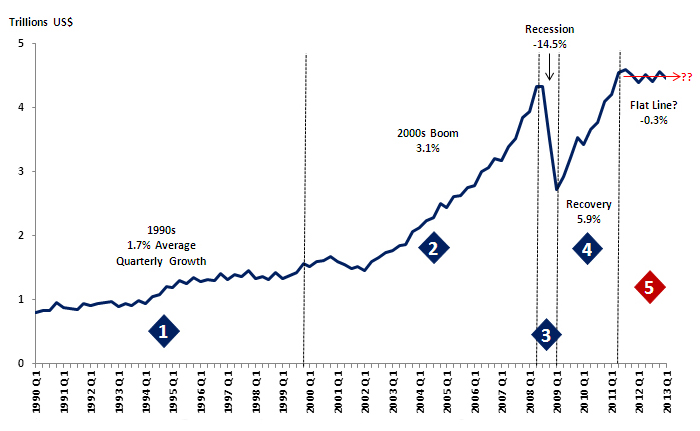Post-crisis world exports: Neither desirable nor dire
From the beginning of the 1990s until the first quarter of this year, world exports increased by more than five times to reach a total of $4.5 trillion, but growth has not been constant throughout this period.
Five Periods of World Export Growth (quartely)

Data: IMF
Source: Office of the Chief Economist, DFATD
World export growth was steady during the 1990s at 1.7 percent (average quarterly growth), while growth in the early 2000s almost doubled that rate by growing at 3.1 percent. The boom in exports from 2000 to 2008 came to a halt when the 2008 crisis hit and world exports plummeted, shrinking by 14.5 percent between the second quarter of 2008 and the first quarter of 2009. World exports were quick to recover from the crisis, posting quarterly growth of 5.9 percent from the first quarter of 2009 to the second quarter of 2011.
However, from the second quarter of 2011 to the first quarter of 2013, world export growth flattened. Reduced exports from advanced economies drove this less-than-stellar performance as they shrank by $134 billion (down 4.8 percent) during this period. This decrease, in turn, was largely a result of economic troubles in Europe. Internal European Union (EU) exports accounted for 60.1 percent of the change in exports from advanced economies (down $100.0 billion). As the EU’s gross domestic product (GDP) shrank by 0.8 percent in the fifth period, this decrease in exports is not surprising.
Going forward, it is expected that world export growth will begin to increase once the EU recovery gains steam. The recent 0.3 percent increase in the EU’s second quarter GDP is reason for optimism, but output is still far below its pre-crisis peak. Moreover, unemployment in the EU continues to worsen — most recently increasing to a discouraging 11 percent.
The EU, however, is not the only region with struggling exports; both Japan and other advanced economies1 also posted declines in exports during the most recent period, falling by $15.7 billion and $34.5 billion, respectively. Only NAFTA and external EU exports increased during this time, expanding by $10.9 billion and $5.3 billion, respectively.
While exports from advanced economies shrank throughout the fifth period, exports from emerging markets grew at an average quarterly rate of 0.3 percent (up $38.9 billion), albeit still slower than their 4.6 percent growth in the early 2000s. Exports from China, increasing by $34.1 billion, contributed the largest portion to the increase in exports from emerging markets.
The Upshot
Although world export growth has recently flat-lined, much of this slowdown is the result of a poor economic climate in Europe. When Europe recovers, it is expected that world export growth will pick up pace — but only time will tell whether growth levels will reach the highs of the early 2000s.
For more information, visit Foreign Affairs, Trade and Development Canada’s Office of the Chief Economist.
1 Other advanced economies include: Australia, Hong Kong, Iceland, Israel, New Zealand, Norway, Singapore, South Korea, Switzerland, and Taiwan.
Subscribe to: CanadExport
- Date Modified: